Laravel 11 CRUD Application Example Tutorial
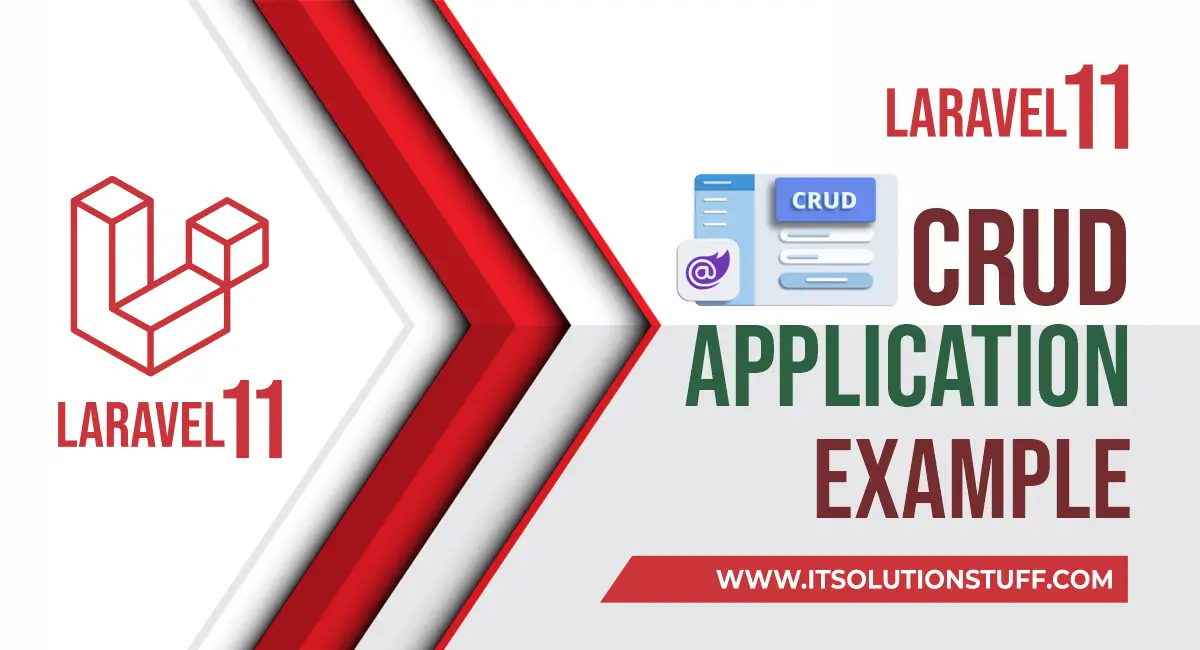
Hi, In this tutorial, I will show you step by step laravel 11 crud operation example.
CRUD Meaning: CRUD is an acronym that comes from the world of computer programming and refers to the four functions that are considered necessary to implement persistent storage in your application: create, read, update, and delete.
We will create a product CRUD application using Laravel 11 in this example. We will create a products table with name and detail columns using Laravel 11 migration. Then, we will create routes, a controller, views, and model files for the product module. We will use Bootstrap 5 for design. So, let's follow the steps below to create CRUD operations with Laravel 11.
Step for Laravel 11 CRUD Operation Example
- Step 1: Install Laravel 11
- Step 2: MySQL Database Configuration
- Step 3: Create Migration
- Step 4: Create Form Request Validation Class
- Step 5: Create Controller and Model
- Step 6: Add Resource Route
- Step 7: Update AppServiceProvider
- Step 8: Add Blade Files
- Run Laravel App
Step 1: Install Laravel 11
First of all, we need to get a fresh Laravel 11 version application using the command below because we are starting from scratch. So, open your terminal or command prompt and run the command below:
composer create-project laravel/laravel example-appStep 2: MySQL Database Configuration
In Laravel 11, there is a default database connection using SQLite, but if we want to use MySQL instead, we need to add a MySQL connection with the database name, username, and password to the `.env` file.
.env
DB_CONNECTION=mysql
DB_HOST=127.0.0.1
DB_PORT=3306
DB_DATABASE=here your database name(blog)
DB_USERNAME=here database username(root)
DB_PASSWORD=here database password(root)Step 3: Create Migration
In the third step, we will create a "products" table with "name" and "details" columns using Laravel migration. So, let's use the following command to create a migration file:
php artisan make:migration create_products_table --create=productsAfter executing the above command, you will find a file in the following path: "database/migrations". You have to put the code below in your migration file to create the products table.
<?php
use Illuminate\Database\Migrations\Migration;
use Illuminate\Database\Schema\Blueprint;
use Illuminate\Support\Facades\Schema;
return new class extends Migration
{
/**
* Run the migrations.
*/
public function up(): void
{
Schema::create('products', function (Blueprint $table) {
$table->id();
$table->string('name');
$table->text('detail');
$table->timestamps();
});
}
/**
* Reverse the migrations.
*/
public function down(): void
{
Schema::dropIfExists('products');
}
};Now you have to run this migration by the following command:
php artisan migrateStep 4: Create Form Request Validation Class
In this step, we will create a form request validation class for the `store()` and `update()` methods in the controller. In this class, we will define validation rules and use it in the controller file. So, let's create it.
php artisan make:request ProductStoreRequestJust put the below code in your request class:
app/Http/Requests/ProductStoreRequest.php
<?php
namespace App\Http\Requests;
use Illuminate\Foundation\Http\FormRequest;
class ProductStoreRequest extends FormRequest
{
/**
* Determine if the user is authorized to make this request.
*/
public function authorize(): bool
{
return true;
}
/**
* Get the validation rules that apply to the request.
*
* @return array|string>
*/
public function rules(): array
{
return [
'name' => 'required',
'detail' => 'required'
];
}
}Now, let's do the same thing for the Update Request Class.
php artisan make:request ProductUpdateRequestJust put the below code in your request class:
app/Http/Requests/ProductUpdateRequest.php
<?php
namespace App\Http\Requests;
use Illuminate\Foundation\Http\FormRequest;
class ProductUpdateRequest extends FormRequest
{
/**
* Determine if the user is authorized to make this request.
*/
public function authorize(): bool
{
return true;
}
/**
* Get the validation rules that apply to the request.
*
* @return array|string>
*/
public function rules(): array
{
return [
'name' => 'required',
'detail' => 'required'
];
}
}Step 5: Create Controller and Model
In this step, now we should create a new resource controller named ProductController. So run the below command to create the new controller. Below is the controller for creating the resource controller.
artisan make:controller ProductController --resource --model=ProductAfter the following command, you will find a new file at this path: "app/Http/Controllers/ProductController.php".
In this controller, seven methods will be created by default as follows:
1)index()
2)create()
3)store()
4)show()
5)edit()
6)update()
7)destroy()
So, let's copy the code below and put it in the ProductController.php file.
app/Http/Controllers/ProductController.php
<?php
namespace App\Http\Controllers;
use App\Models\Product;
use Illuminate\Http\RedirectResponse;
use Illuminate\Http\Request;
use Illuminate\Http\Response;
use Illuminate\View\View;
use App\Http\Requests\ProductStoreRequest;
use App\Http\Requests\ProductUpdateRequest;
class ProductController extends Controller
{
/**
* Display a listing of the resource.
*/
public function index(): View
{
$products = Product::latest()->paginate(5);
return view('products.index', compact('products'))
->with('i', (request()->input('page', 1) - 1) * 5);
}
/**
* Show the form for creating a new resource.
*/
public function create(): View
{
return view('products.create');
}
/**
* Store a newly created resource in storage.
*/
public function store(ProductStoreRequest $request): RedirectResponse
{
Product::create($request->validated());
return redirect()->route('products.index')
->with('success', 'Product created successfully.');
}
/**
* Display the specified resource.
*/
public function show(Product $product): View
{
return view('products.show',compact('product'));
}
/**
* Show the form for editing the specified resource.
*/
public function edit(Product $product): View
{
return view('products.edit',compact('product'));
}
/**
* Update the specified resource in storage.
*/
public function update(ProductUpdateRequest $request, Product $product): RedirectResponse
{
$product->update($request->validated());
return redirect()->route('products.index')
->with('success','Product updated successfully');
}
/**
* Remove the specified resource from storage.
*/
public function destroy(Product $product): RedirectResponse
{
$product->delete();
return redirect()->route('products.index')
->with('success','Product deleted successfully');
}
}So, let's update the Product model code as follows:
app/Models/Product.php
<?php
namespace App\Models;
use Illuminate\Database\Eloquent\Factories\HasFactory;
use Illuminate\Database\Eloquent\Model;
class Product extends Model
{
use HasFactory;
protected $fillable = [
'name',
'detail',
];
}Step 6: Add Resource Route
Here, we need to add a resource route for the product CRUD application. So, open your `routes/web.php` file and add the following route.
routes/web.php
<?php
use Illuminate\Support\Facades\Route;
use App\Http\Controllers\ProductController;
Route::get('/', function () {
return view('welcome');
});
Route::resource('products', ProductController::class);Step 7: Update AppServiceProvider
Here, we will use bootstrap 5 for pagination. so, we need to import it on AppServiceProvider.php file. let's update it.
app/Provides/AppServiceProvider.php
<?php
namespace App\Providers;
use Illuminate\Support\ServiceProvider;
use Illuminate\Pagination\Paginator;
class AppServiceProvider extends ServiceProvider
{
/**
* Register any application services.
*/
public function register(): void
{
}
/**
* Bootstrap any application services.
*/
public function boot(): void
{
Paginator::useBootstrapFive();
}
}
Step 8: Add Blade Files
In the last step, we need to create only blade files. So, primarily, we have to create a layout file and then a new folder called "products." After that, we create blade files for the CRUD app. So, finally, you have to create the following blade files below:
1) layout.blade.php
2) index.blade.php
3) create.blade.php
4) edit.blade.php
5) show.blade.php
So let's just create the following file and put the code below in it.
resources/views/products/layout.blade.php
<!DOCTYPE html>
<html>
<head>
<title>Laravel 11 CRUD Application - ItSolutionStuff.com</title>
<link href="https://cdn.jsdelivr.net/npm/bootstrap@5.3.2/dist/css/bootstrap.min.css" rel="stylesheet">
<link rel="stylesheet" href="https://cdnjs.cloudflare.com/ajax/libs/font-awesome/6.5.1/css/all.min.css" />
</head>
<body>
<div class="container">
@yield('content')
</div>
</body>
</html>resources/views/products/index.blade.php
@extends('products.layout')
@section('content')
<div class="card mt-5">
<h2 class="card-header">Laravel 11 CRUD Example from scratch - ItSolutionStuff.com</h2>
<div class="card-body">
@session('success')
<div class="alert alert-success" role="alert"> {{ $value }} </div>
@endsession
<div class="d-grid gap-2 d-md-flex justify-content-md-end">
<a class="btn btn-success btn-sm" href="{{ route('products.create') }}"> <i class="fa fa-plus"></i> Create New Product</a>
</div>
<table class="table table-bordered table-striped mt-4">
<thead>
<tr>
<th width="80px">No</th>
<th>Name</th>
<th>Details</th>
<th width="250px">Action</th>
</tr>
</thead>
<tbody>
@forelse ($products as $product)
<tr>
<td>{{ ++$i }}</td>
<td>{{ $product->name }}</td>
<td>{{ $product->detail }}</td>
<td>
<form action="{{ route('products.destroy',$product->id) }}" method="POST">
<a class="btn btn-info btn-sm" href="{{ route('products.show',$product->id) }}"><i class="fa-solid fa-list"></i> Show</a>
<a class="btn btn-primary btn-sm" href="{{ route('products.edit',$product->id) }}"><i class="fa-solid fa-pen-to-square"></i> Edit</a>
@csrf
@method('DELETE')
<button type="submit" class="btn btn-danger btn-sm"><i class="fa-solid fa-trash"></i> Delete</button>
</form>
</td>
</tr>
@empty
<tr>
<td colspan="4">There are no data.</td>
</tr>
@endforelse
</tbody>
</table>
{!! $products->links() !!}
</div>
</div>
@endsectionresources/views/products/create.blade.php
@extends('products.layout')
@section('content')
<div class="card mt-5">
<h2 class="card-header">Add New Product</h2>
<div class="card-body">
<div class="d-grid gap-2 d-md-flex justify-content-md-end">
<a class="btn btn-primary btn-sm" href="{{ route('products.index') }}"><i class="fa fa-arrow-left"></i> Back</a>
</div>
<form action="{{ route('products.store') }}" method="POST">
@csrf
<div class="mb-3">
<label for="inputName" class="form-label"><strong>Name:</strong></label>
<input
type="text"
name="name"
class="form-control @error('name') is-invalid @enderror"
id="inputName"
placeholder="Name">
@error('name')
<div class="form-text text-danger">{{ $message }}</div>
@enderror
</div>
<div class="mb-3">
<label for="inputDetail" class="form-label"><strong>Detail:</strong></label>
<textarea
class="form-control @error('detail') is-invalid @enderror"
style="height:150px"
name="detail"
id="inputDetail"
placeholder="Detail"></textarea>
@error('detail')
<div class="form-text text-danger">{{ $message }}</div>
@enderror
</div>
<button type="submit" class="btn btn-success"><i class="fa-solid fa-floppy-disk"></i> Submit</button>
</form>
</div>
</div>
@endsectionresources/views/products/edit.blade.php
@extends('products.layout')
@section('content')
<div class="card mt-5">
<h2 class="card-header">Edit Product</h2>
<div class="card-body">
<div class="d-grid gap-2 d-md-flex justify-content-md-end">
<a class="btn btn-primary btn-sm" href="{{ route('products.index') }}"><i class="fa fa-arrow-left"></i> Back</a>
</div>
<form action="{{ route('products.update',$product->id) }}" method="POST">
@csrf
@method('PUT')
<div class="mb-3">
<label for="inputName" class="form-label"><strong>Name:</strong></label>
<input
type="text"
name="name"
value="{{ $product->name }}"
class="form-control @error('name') is-invalid @enderror"
id="inputName"
placeholder="Name">
@error('name')
<div class="form-text text-danger">{{ $message }}</div>
@enderror
</div>
<div class="mb-3">
<label for="inputDetail" class="form-label"><strong>Detail:</strong></label>
<textarea
class="form-control @error('detail') is-invalid @enderror"
style="height:150px"
name="detail"
id="inputDetail"
placeholder="Detail">{{ $product->detail }}</textarea>
@error('detail')
<div class="form-text text-danger">{{ $message }}</div>
@enderror
</div>
<button type="submit" class="btn btn-success"><i class="fa-solid fa-floppy-disk"></i> Update</button>
</form>
</div>
</div>
@endsectionresources/views/products/show.blade.php
@extends('products.layout')
@section('content')
<div class="card mt-5">
<h2 class="card-header">Show Product</h2>
<div class="card-body">
<div class="d-grid gap-2 d-md-flex justify-content-md-end">
<a class="btn btn-primary btn-sm" href="{{ route('products.index') }}"><i class="fa fa-arrow-left"></i> Back</a>
</div>
<div class="row">
<div class="col-xs-12 col-sm-12 col-md-12">
<div class="form-group">
<strong>Name:</strong> <br/>
{{ $product->name }}
</div>
</div>
<div class="col-xs-12 col-sm-12 col-md-12 mt-2">
<div class="form-group">
<strong>Details:</strong> <br/>
{{ $product->detail }}
</div>
</div>
</div>
</div>
</div>
@endsectionRun Laravel App:
All the required steps have been done, now you have to type the given below command and hit enter to run the Laravel app:
php artisan serveNow, Go to your web browser, type the given URL and view the app output:
http://localhost:8000/productsYou will see layout bellow:
List Page:
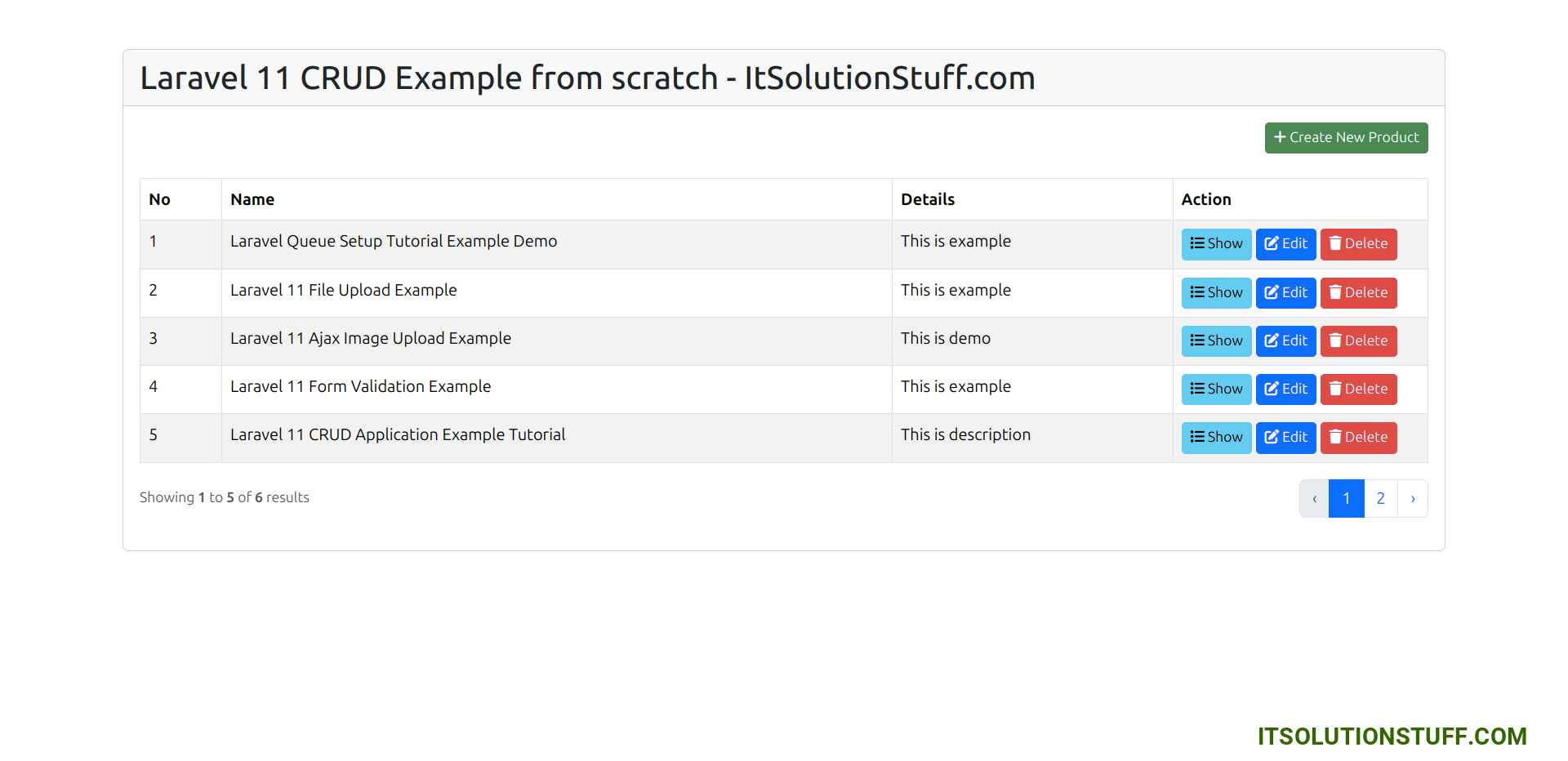
Add Page:
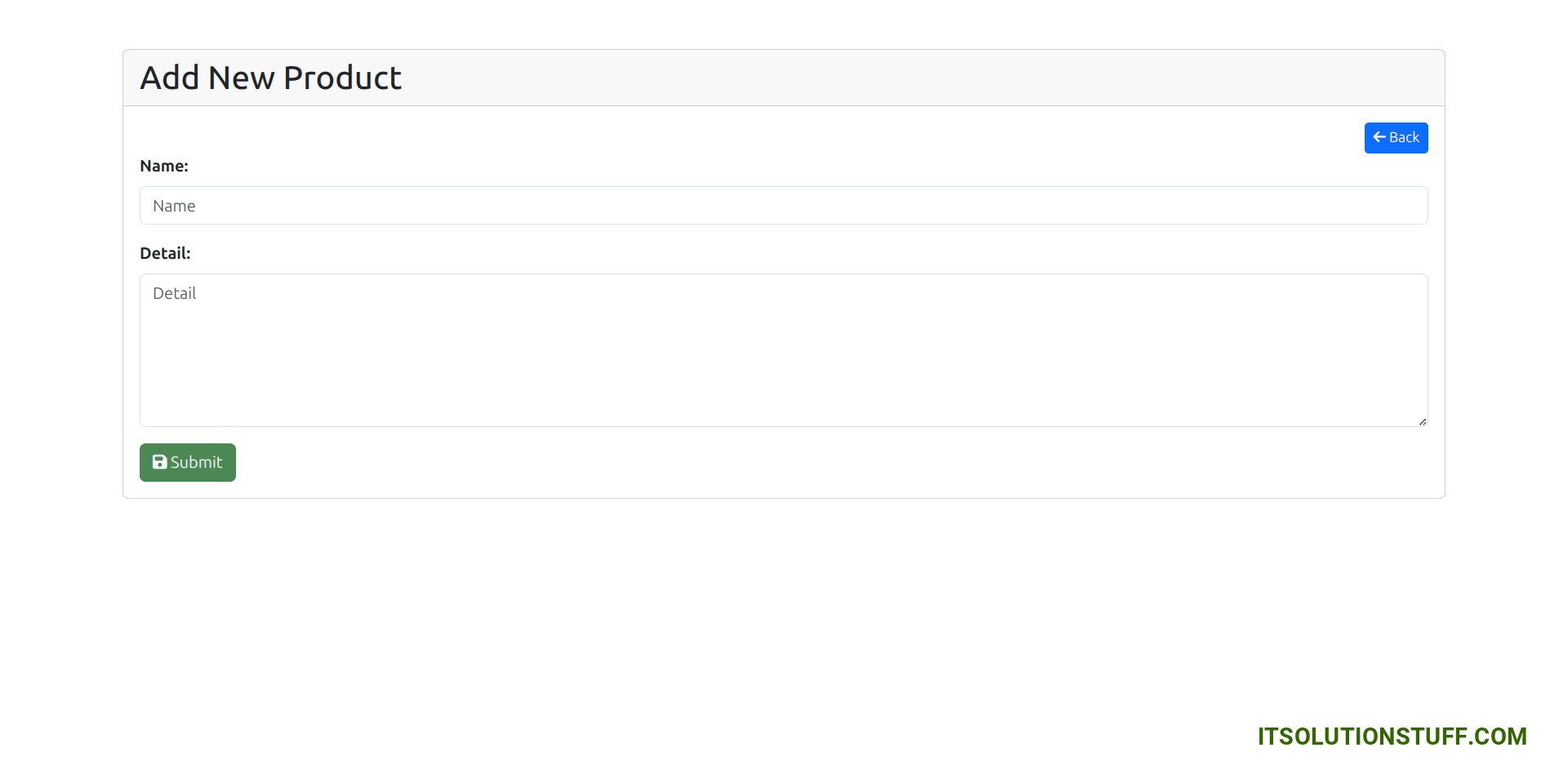
Edit Page:
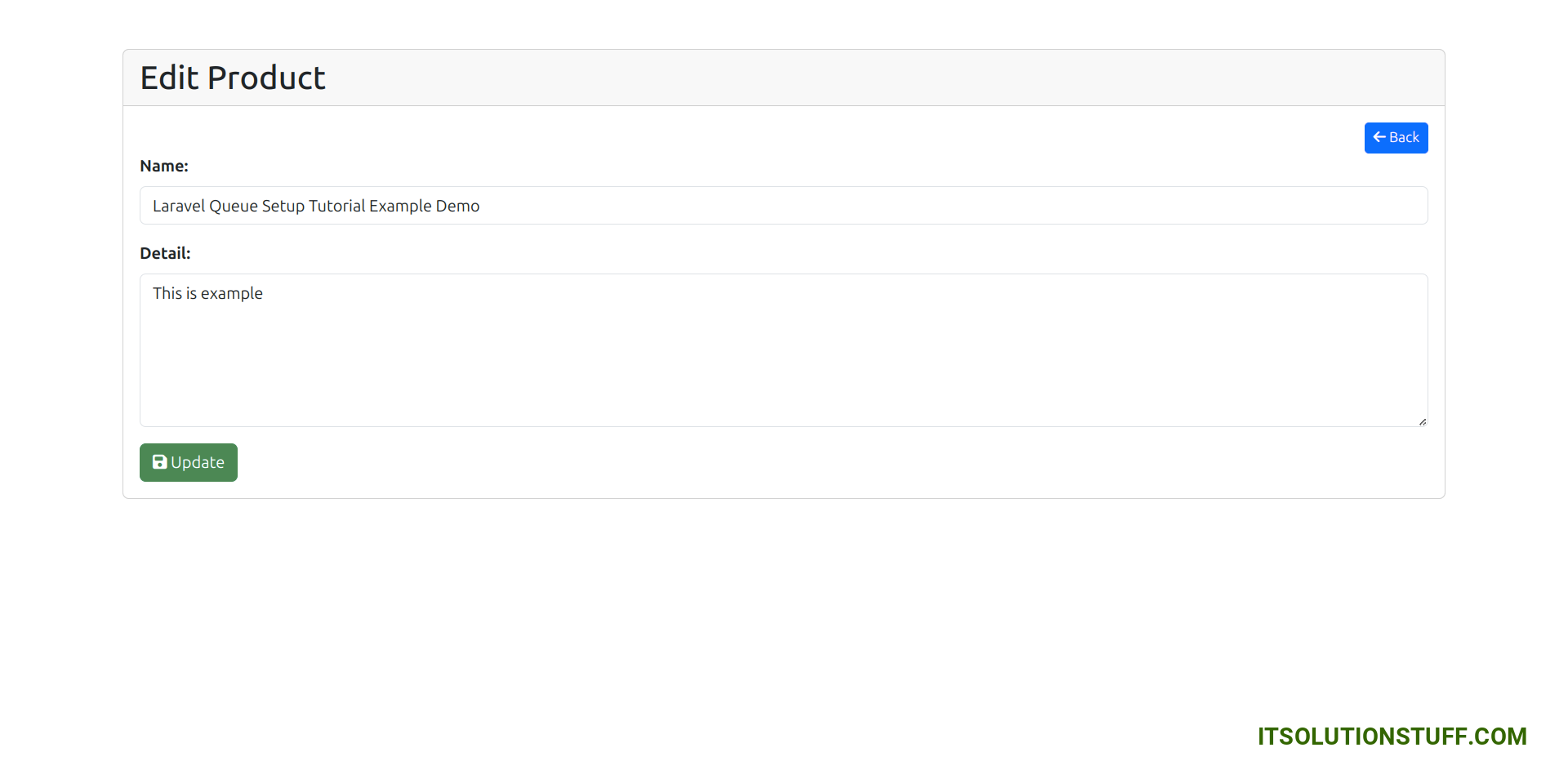
Show Page:
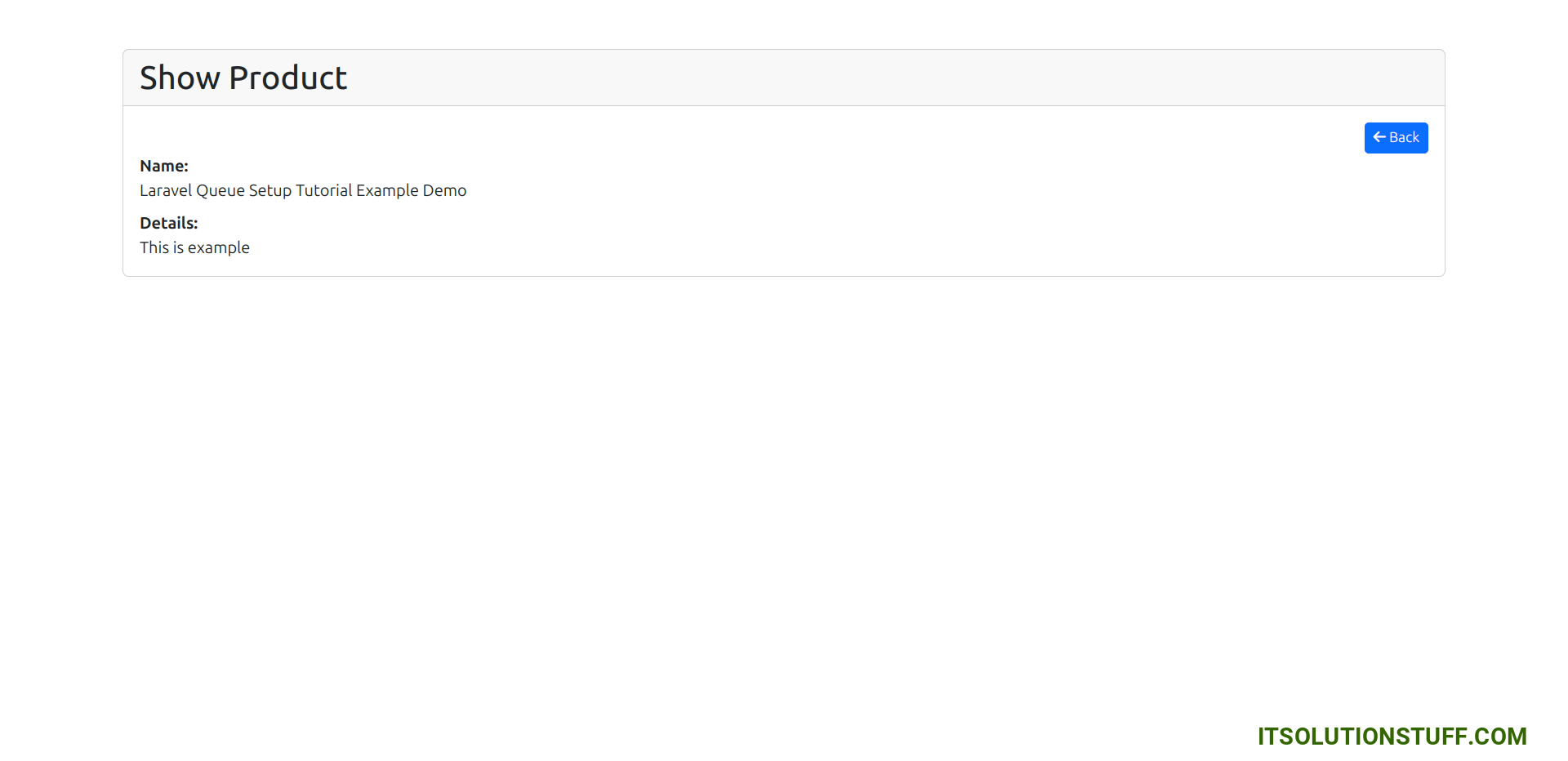
You can download code from git:
Download Code from Github for Laravel 11 CRUD App
I hope it can help you...

